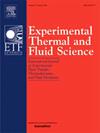An experimental investigation of transient ice accretion process on a high-lift airfoil model for UAV applications
IF 3.3
2区 工程技术
Q2 ENGINEERING, MECHANICAL
Experimental Thermal and Fluid Science
Pub Date : 2025-09-13
DOI:10.1016/j.expthermflusci.2025.111612
引用次数: 0
Abstract
An experimental study is performed to investigate the transient ice accretion process along the surface of a high-lift, S1223 airfoil model, and the icing-induced aerodynamic performance degradation. The UAV airfoil model was exposed to typically glaze and rime icing conditions encountered by UAVs flying in low-altitude airspace. While the rime ice accretion was found to conform with the original profile of the UAV airfoil model well in general, substantial “feather-like” ice roughness elements were observed to grow rapidly over both the suction-side and pressure-side surfaces near the airfoil leading edge. The glaze ice accretion process was featured by obvious wind-driven water runback to transport the unfrozen water mass from the airfoil frontal surface to further downstream locations, causing the formation of complex rivulet-shaped ice structures and growth of ice “horns” along the leading edge and “finger-liked icicles” near the trailing edge. The aerodynamic performance of the UAV airfoil was found to degrade continuously with the increasing ice accretion time. The ice accretion over a period of 463 s was found to reduce UAV endurance from 18% to 46 % and diminish the UAV flying range by 13 % to 40 %, depending on the nature of ice accreted. The acquired ice accretion images were coordinated with the aerodynamic force measurements to gain further insight into the underlying physics for a better understanding of the UAV inflight icing phenomena.
无人机大升力翼型模型瞬态结冰过程的实验研究
通过实验研究了高升力S1223翼型模型表面瞬态结冰过程以及结冰引起的气动性能下降。无人机翼型模型暴露在无人机在低空空域飞行时遇到的典型釉和霜结冰条件下。而时间冰的增加被发现符合无人机翼型模型的原始轮廓很好,在一般情况下,大量的“羽状”冰粗糙度元素被观察到在吸侧和压力侧表面附近翼型前缘迅速增长。釉面结冰过程的特点是明显的风驱动水倒流,将未冻结的水团从翼型前表面输送到更下游的位置,形成复杂的小溪状冰结构,前缘形成冰“角”,后缘附近形成“指状冰柱”。研究发现,随着结冰时间的增加,无人机翼型的气动性能不断下降。在463秒期间的冰的增加被发现减少无人机的续航力从18%到46%并且减少无人机的飞行距离13%到40%,这取决于冰的增加的性质。获取的冰积图像与气动力测量相协调,以进一步了解潜在的物理现象,以便更好地理解无人机飞行结冰现象。
本文章由计算机程序翻译,如有差异,请以英文原文为准。
求助全文
约1分钟内获得全文
求助全文
来源期刊

Experimental Thermal and Fluid Science
工程技术-工程:机械
CiteScore
6.70
自引率
3.10%
发文量
159
审稿时长
34 days
期刊介绍:
Experimental Thermal and Fluid Science provides a forum for research emphasizing experimental work that enhances fundamental understanding of heat transfer, thermodynamics, and fluid mechanics. In addition to the principal areas of research, the journal covers research results in related fields, including combined heat and mass transfer, flows with phase transition, micro- and nano-scale systems, multiphase flow, combustion, radiative transfer, porous media, cryogenics, turbulence, and novel experimental techniques.
 求助内容:
求助内容: 应助结果提醒方式:
应助结果提醒方式:


